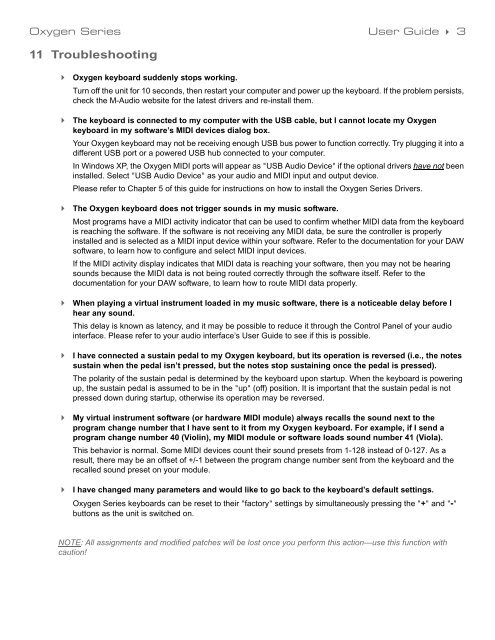Oxygen Series - M-Audio
Oxygen Series - M-Audio
Oxygen Series - M-Audio
You also want an ePaper? Increase the reach of your titles
YUMPU automatically turns print PDFs into web optimized ePapers that Google loves.
<strong>Oxygen</strong> <strong>Series</strong> User Guide 3<br />
11 Troubleshooting<br />
<strong>Oxygen</strong> keyboard suddenly stops working.<br />
Turn off the unit for 10 seconds, then restart your computer and power up the keyboard. If the problem persists,<br />
check the M-<strong>Audio</strong> website for the latest drivers and re-install them.<br />
The keyboard is connected to my computer with the USB cable, but I cannot locate my <strong>Oxygen</strong><br />
keyboard in my software’s MIDI devices dialog box.<br />
Your <strong>Oxygen</strong> keyboard may not be receiving enough USB bus power to function correctly. Try plugging it into a<br />
different USB port or a powered USB hub connected to your computer.<br />
In Windows XP, the <strong>Oxygen</strong> MIDI ports will appear as "USB <strong>Audio</strong> Device" if the optional drivers have not been<br />
installed. Select "USB <strong>Audio</strong> Device" as your audio and MIDI input and output device.<br />
Please refer to Chapter 5 of this guide for instructions on how to install the <strong>Oxygen</strong> <strong>Series</strong> Drivers.<br />
The <strong>Oxygen</strong> keyboard does not trigger sounds in my music software.<br />
Most programs have a MIDI activity indicator that can be used to confirm whether MIDI data from the keyboard<br />
is reaching the software. If the software is not receiving any MIDI data, be sure the controller is properly<br />
installed and is selected as a MIDI input device within your software. Refer to the documentation for your DAW<br />
software, to learn how to configure and select MIDI input devices.<br />
If the MIDI activity display indicates that MIDI data is reaching your software, then you may not be hearing<br />
sounds because the MIDI data is not being routed correctly through the software itself. Refer to the<br />
documentation for your DAW software, to learn how to route MIDI data properly.<br />
When playing a virtual instrument loaded in my music software, there is a noticeable delay before I<br />
hear any sound.<br />
This delay is known as latency, and it may be possible to reduce it through the Control Panel of your audio<br />
interface. Please refer to your audio interface’s User Guide to see if this is possible.<br />
I have connected a sustain pedal to my <strong>Oxygen</strong> keyboard, but its operation is reversed (i.e., the notes<br />
sustain when the pedal isn’t pressed, but the notes stop sustaining once the pedal is pressed).<br />
The polarity of the sustain pedal is determined by the keyboard upon startup. When the keyboard is powering<br />
up, the sustain pedal is assumed to be in the "up" (off) position. It is important that the sustain pedal is not<br />
pressed down during startup, otherwise its operation may be reversed.<br />
My virtual instrument software (or hardware MIDI module) always recalls the sound next to the<br />
program change number that I have sent to it from my <strong>Oxygen</strong> keyboard. For example, if I send a<br />
program change number 40 (Violin), my MIDI module or software loads sound number 41 (Viola).<br />
This behavior is normal. Some MIDI devices count their sound presets from 1-128 instead of 0-127. As a<br />
result, there may be an offset of +/-1 between the program change number sent from the keyboard and the<br />
recalled sound preset on your module.<br />
I have changed many parameters and would like to go back to the keyboard’s default settings.<br />
<strong>Oxygen</strong> <strong>Series</strong> keyboards can be reset to their "factory" settings by simultaneously pressing the "+" and "-"<br />
buttons as the unit is switched on.<br />
NOTE: All assignments and modified patches will be lost once you perform this action—use this function with<br />
caution!

















